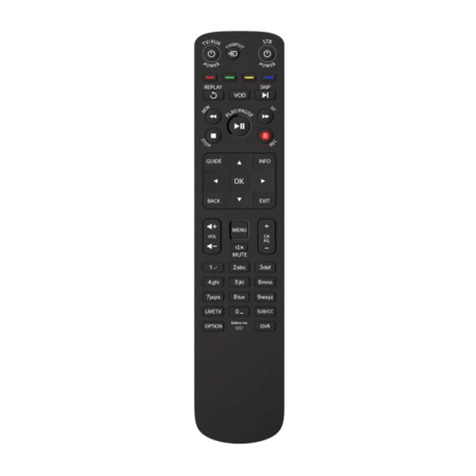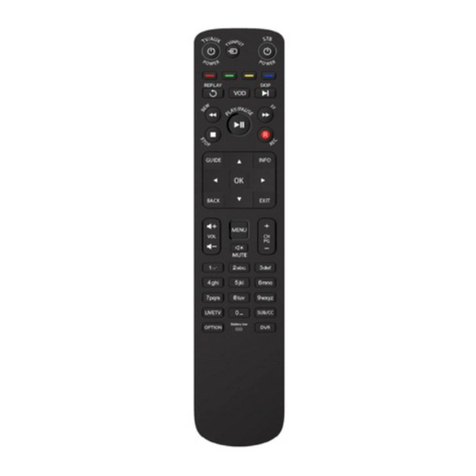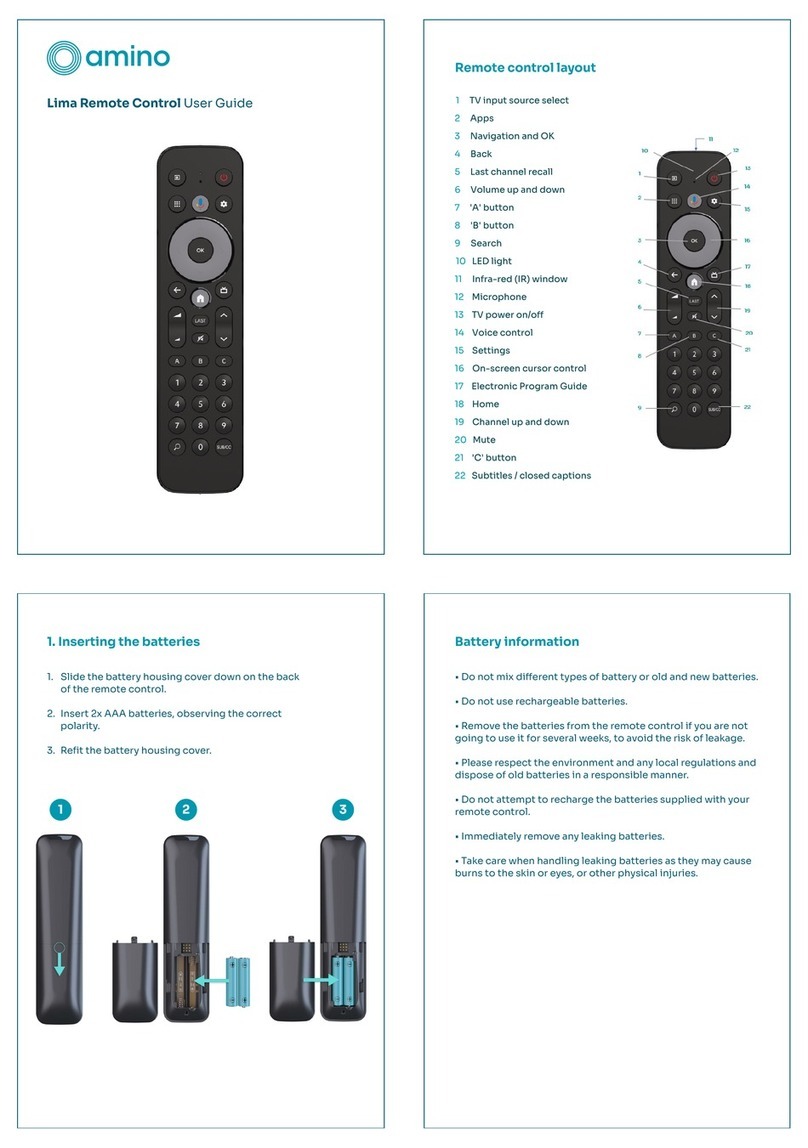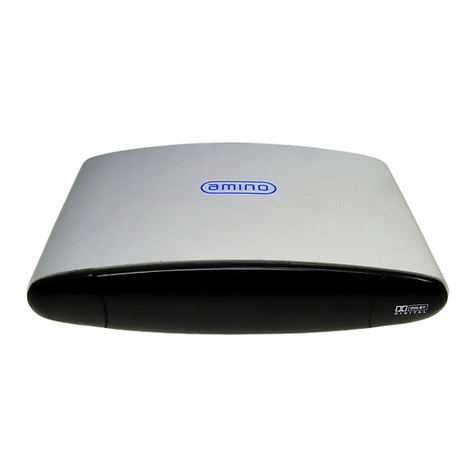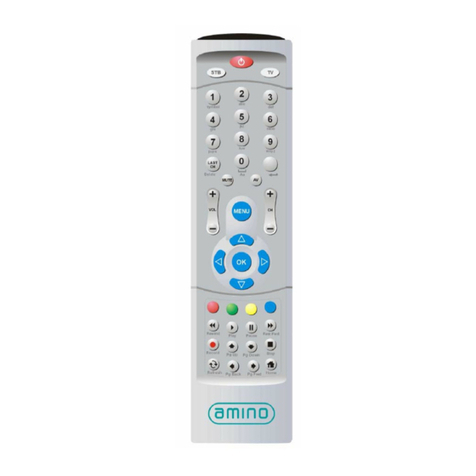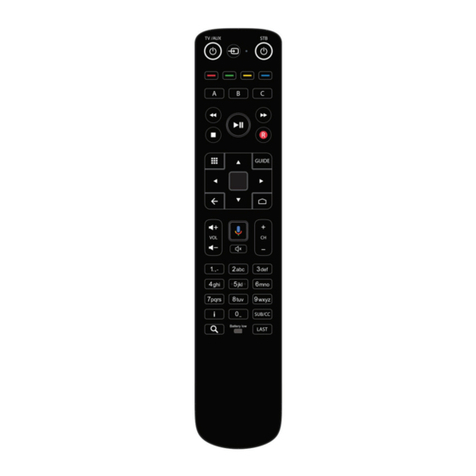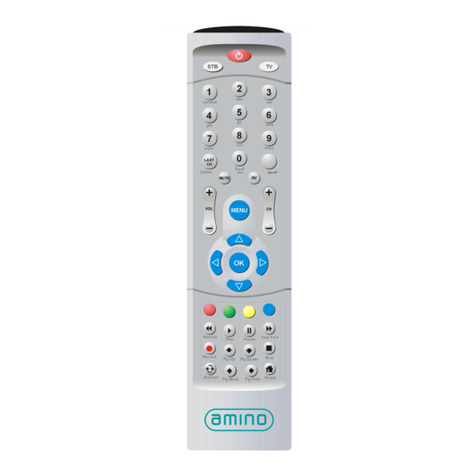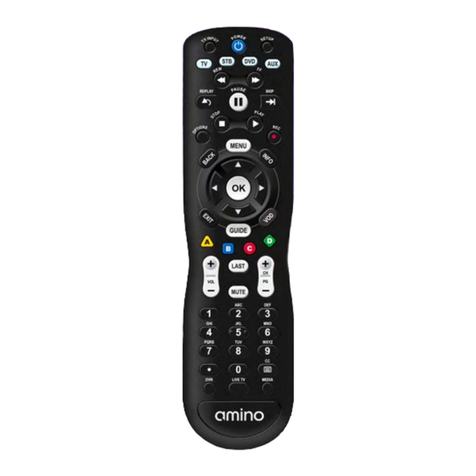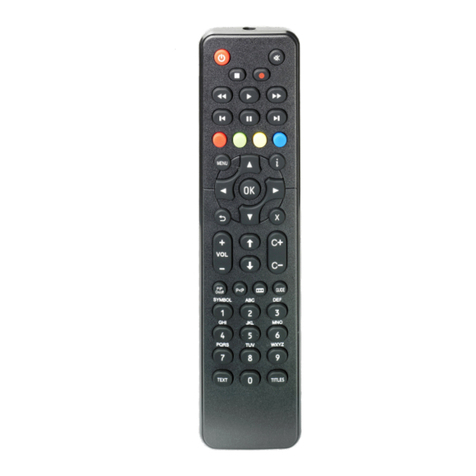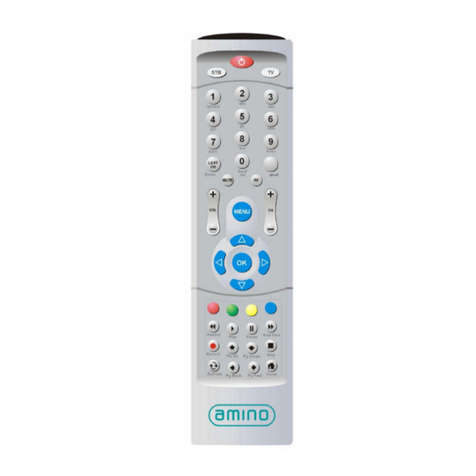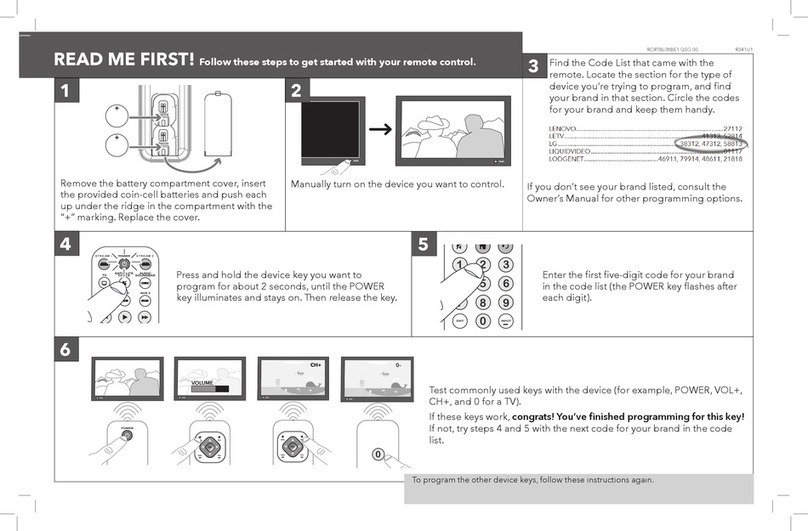
4. Controlling the TV with your Maxi
Remote Control (brand search)
The TV/AUX POWER (2), TV INPUT (1), VOL+, VOL- (9) and MUTE (21)
keys on the Maxi Linux remote control can be programmed so that
they control the relevant functions on your TV.
To do this, your remote control must rst learn the ‘brand code’ of
your TV. By default, the remote control is programmed with the most
common brand code 1150 (Samsung).
1. On our website, visit the resources page (amino.tv/resources) and
select the TV Brand Codes document for Maxi remote controls.
Identify the 4-digit brand code for your brand of TV.
2. Make sure your TV is turned on. The STB does not need to be
turned on for this operation.
3. Press the MENU key (19) and the number 1 text entry key
simultaneously until the STB power key (14) ashes twice to
indicate it has entered brand search mode.
4. Perform the brand search using one of the following methods:
• Code entry - If you know your TV brand code, press the 2 and 6
text entry keys simultaneously until the TV/AUX POWER key (2)
ashes twice and remains on. Now enter your 4-digit code using
the text entry keys.
• Auto search - If you don’t know your TV brand code, press the 1
and 3 text entry keys simultaneously until the TV/AUX POWER (2)
key ashes twice and remains on. Now enter 9 9 9 9 to enter auto
brand search mode.
5. For either method of brand search, the TV/AUX POWER key (2) will
ash once and remain on to conrm a successful connection with
your TV. You can test it by pressing either the TV/AUX POWER key
(2) or the MUTE key (21) to conrm that the TV responds.
6. If brand search has been unsuccessful, the TV/AUX POWER key
(2) will give a long ash. Press Back (8) to exit brand search mode.
See section 5 of this user guide for details on how to ‘teach’ your
remote to control your TV.
5. Learning mode – For use if Brand Search
is unsuccessful
If the brand search process described in section 4 is unsuccessful, it
is possible for the Maxi Linux remote control to ‘learn’ a key function
from another ‘source’ remote control.
1. Choose your ‘target key’ on the Maxi Linux remote control. This
key will be the one that learns the function from the source
remote control. It must be one of the following keys: TV/AUX
POWER (2), TV INPUT (1), VOL+, VOL- (9), MUTE (21).
2. Press and hold the numbers 4 and 6 on your Maxi Linux remote
control simultaneously until the TV/AUX POWER key (2) ashes
and then remains on.
3. Press your target key on the Maxi Linux remote control:
• if this is a valid key for learning mode, the TV/AUX POWER key (2)
will give a conrmation ash. You can now release the target key
and move to step 4.
• if your chosen target key is invalid for learning mode, or you do
not press within 30 seconds, the TV/AUX POWER key (2) will give
a long ash and the Maxi Linux remote control will return to user
mode. Release the Target Key and try again from step 2.
4. Hold the Maxi Linux remote control 3 - 6 cm from the source
remote control with the IR windows facing each other. Press your
chosen key on the source remote control (On/O, Source, Vol +,
Vol -, Mute).
5. If the IR signal is received correctly, the TV/AUX POWER key (2)
will ash twice and the Maxi Linux remote control will return to
normal mode with the new function added to the target key. This
will overwrite any previously learned code on the target key).
6. If the IR signal is not received correctly, or is received after 30
seconds, the TV/AUX POWER key (2) will give a long ash and the
Maxi Linux remote control will return to user mode.
7. If any key is pressed on the Maxi Linux remote control while it is
waiting for an IR signal, the TV/AUX POWER key (2) will give a long
ash and the Maxi Linux remote control will return to unormal
mode.
8. To clear a target key of any previously learned function, press
and hold the 4 and 6 keys for at least three seconds until the TV/
AUX POWER key (2) ashes and remains on. Press your target key
twice. The TV/AUX POWER key (2) will ash to conrm the target
key has been cleared.
6. How do I return my remote to Factory
Settings?
1. Press and hold numbers 1 and 6 until the TV/AUX POWER key
flashes, then remains on.
2. Enter the key sequence 9 8 1 on the remote control text entry
keys. The STB POWER key (14) will flash and the remote control
will be reset to its factory settings.
99-709852-09 Rev. 01-02
3. Set-top box control setup (pairing)
To use your STB, you must pair it with your Maxi Linux Remote
Control using Bluetooth. Your remote control can only pair with one
STB at a time.
Ensure the STB is powered on, connected to a TV, and has nished
its start-up procedure. Ensure your TV input source is set to display
the output from the STB.
Depending on your service provider, pairing instructions may be
shown on screen when you connect your STB to a TV (e.g. as a setup
wizard). In this case, follow the on screen instructions. If no instructions
are shown on screen, follow the pairing instructions below.
Note: During pairing, the only remote control keys that will work are
the STB power (14) and BACK (8) keys. You must press BACK (8) to
stop pairing or to use any other function.
Auto pairing with your STB
1. The remote control will automatically enter pairing mode for 60
seconds after the batteries have been inserted.
2. Press any key to start pairing your remote control to your STB. The
STB POWER key (14) will ash to conrm the keypress.
3. Follow the on-screen instructions on your TV to pair your remote
and STB.
If auto pairing is unsuccessful, you can pair the remote control
manually as follows:
Manual pairing with your STB
1. Press the MENU (19) and OK (7) keys simultaneously until the
STB POWER key (14) ashes to acknowledge the manual pairing
request. ‘Searching for accessories’ is shown on the TV screen.
2. The STB POWER key (14) ashes once to conrm successful
pairing. The STB may also display an on-screen message,
depending on the version of software installed.
Note: Pairing may not be successful on the rst attempt. If pairing
is unsuccessful, the TV/AUX POWER key (2) gives a long ash to
indicate an error. It is advisable to make a few further attempts at
manual pairing before contacting your service provider.
